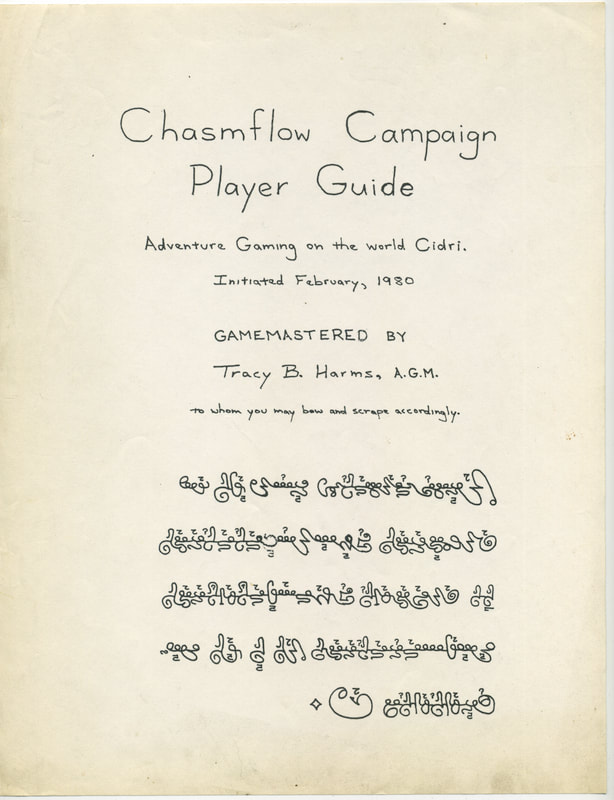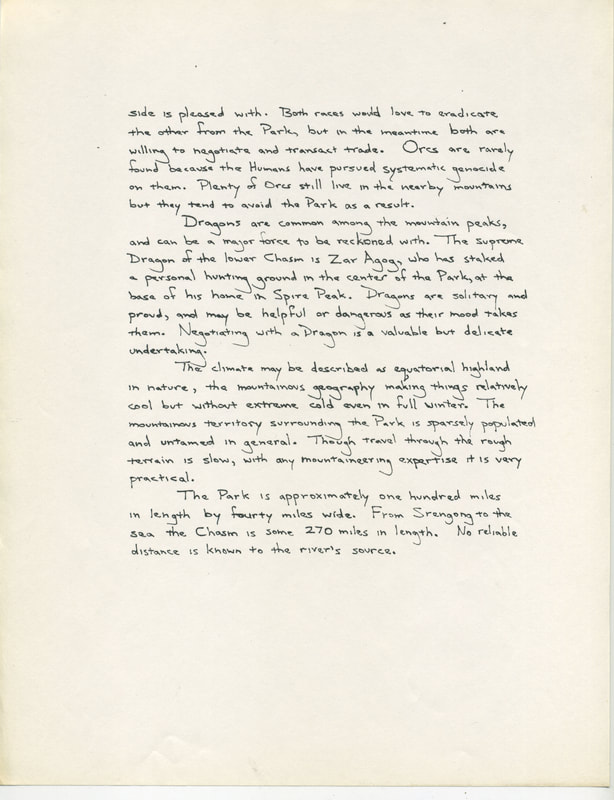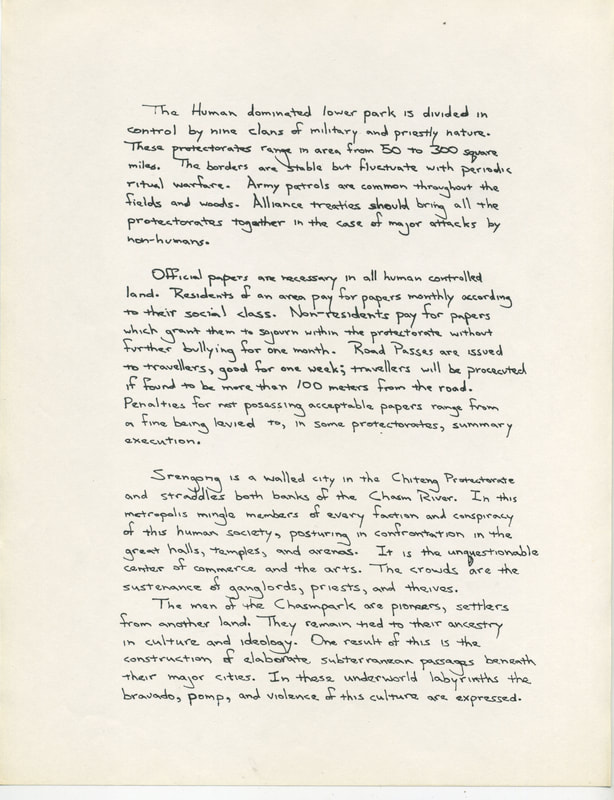|
Yes, I know, I often come off as a real snob about RPG's. It's a combination of being older and also having played with really sophisticated gamers. In order to illustrate why I am a game snob, I once again am climbing onto my High Hobby Horse of Gamer Wisdom to talk about a campaign I took part in beginning around 1978-1979, or so. A bit of snobbery about AD&D. By 1979 my group had outgrown D&D. I had all the AD&D books. Yet these newer D&D rules had all the same problems as OD&D. Our group wanted a deeper concept and better rules. In those days Deep Concept meant one thing - Empire of the Petal Throne. My good friend Tracy Harms and I both had copies of the game and we agreed that this was the ultimate setting and that we needed to play it. Yet it too is merely an OD&D game system, thus it is limited by the same kludgy mechanics as OD&D and AD&D. Perhaps a month later Tracy showed up at my house and along with another friend, Curtiss a.k.a. Dirty Curt, we played an RPG set in Tekumel for the first time as we explored the ruins of an ancient palace. For the record, the game we played was incredibly deadly and trashed all of our characters. Curt got a bit brave and got his character killed while I was able to find some loot and escape with my lives. Tracy had done what most of us did in those days and devised his own rules by using someone else's game. In this case it was The Fantasy Trip: Melee and Wizard. He grafted these two simple pocket sized games onto his own rules for adventuring. He also began communicating and sharing his ideas with Steve Jackson the author of those games. Thus our group became a kind of play test group. We played this adapted E.P.T. game in the Tekumel setting for about a year. When the rules for Melee and Wizard as an RPG came out we were somewhat awed to see that Tracy's name was the top credit in the list of play testers. I even underlined his name in my own copy of In the Labyrinth. With the newly published TFT: ITL rules in hand Tracy moved our campaign to the ITL world setting, a ring world called Cidri. Yet our campaign became an amalgamation of both E.P.T. and ITL. The big -What If?- of the new campaign was simple. What if a group of humans from Tekumel went to Cidri and created an enclave that blended traditional RPG fantasy, some weird science stuff, and Tekumel? Thus in 1980 our semi by the book E.P.T. campaign ended and the Chasmflow Campaign began. Tracy now had the freedom to create his own variant on E.P.T. that was just as complex as the original. We players received our own players handbook for the campaign which outlined all the background and political intrigue, a setting map, and a lot of new rules he had devised that do not appear in the published versions of either E.P.T. or ITL. Many thanks to Tracy for his creation as we finally had the kind of game we really desired. As citizens in a complex society much of what we did is best described as Spy Work, or even Commando Operations. We would be approached by a mysterious person who was seeking to do something. We were the hired swords, mages, and priests who would perform tasks for our patrons. Along the way we discovered more of the rich history of this place we now lived in. We also developed an appreciation for the machiavellian complexity of local politics, as we had to pay fee's to cross between the borders of the various protectorates and depending on who we were working for, also had to watch out for agents from other competing factions. To this day, the Chasmflow campaign has remained in my memory as a paragon in RPG gaming. When I speak with younger, or new gamers, and they tell me me how until the present day people did not truly Role Play, and that our games were not very well developed back in those early days, I tend to get a bit miffed. Our forays into Tekumel began just 4-5 years after the 1st publication of D&D (1974). While our rules may have been minimal, our stories were not. Even then we were pushing the envelope on depth of story and complexity of culture that does not exist in off-the-shelf products today. We did it by drawing on the finest games we could find and also by self publishing our own campaigns for our friends to play in. It is also a wonder to me that I have managed to save this collection of play notes that Tracy created for all this time, as it has been nearly 40 years since we played this game. These images are just a selection of pages as I feel this variant belongs to Tracy and it includes several adaptations and variants for use with ITL that are his own inventions. Yet I felt I could show the lore and the culture as an example of how we played and argue that: no we weren't a bunch of bozos back in the day. We actually may have been playing in a much more refined manner even then. This is a nice trip back to The Fantasy Trip for me.
These pages were a launching point for at least a year's more gaming, if not longer. The campaign was a long evolution of ideas and rules that must have lasted a total of 4 years. As the explorers of this fascinating yet dangerous place we worked hard to uncover old lore and secrets. With Tracy as Referee there were no free rolls to gain anything, it all had to be played out and negotiated via our own wits. We literally fought and died for the knowledge we attained. We also forged a highly team based style of play that was tactical & cooperative. We planned strategy before simply attacking the monsters, which I would say is unlike the typical smash and grab I encounter these days. Thanks for reading, Griff
13 Comments
12/7/2019 09:58:27 pm
I think Prof. Barker would have been delighted that you found another one of the worlds sent to their own pocket dimensions, just like Tekumel. (And that's a nice bit of Tsolyani there in your notes - I might translate it, if you like)
Reply
Hey Victor!
Reply
Angantyr
12/8/2019 10:27:16 am
Wow! You should try to convince Tracy to publish this!
Reply
Mark Haynes
12/8/2019 12:47:17 pm
A little context for the younger readers regarding AD&D. It was a piecemeal release and by 1979, consisted all of 3 rulebooks: The Monster Manual, The Player's Handbook and lastly, newly released in 1979 was the Dungeon Master's Guide, a huge tome of many pages and priced at a staggering $14.95...
Reply
ANGANTYR
12/8/2019 05:35:15 pm
A little further context: the MicroGames Melee and Wizard were $2.95 each (the Advanced versions were $4.95, IIRC) and In The Labyrinth (the TFT equivalent to the AD&D DM's Guide) was either $4.95 or $5.95 (again, IIRC).
Reply
2/26/2020 04:33:22 pm
I saw this at SJgames.com.
Reply
Yeah, it seems like most go through the same kind of evolution. The first intro is a mix of hack and slash and a lot of cautious exploration, then we get into deeper stories and motives and desires and explore that.
Reply
Nathan Easton
8/17/2020 04:37:14 pm
I hope you're still watching this post!
Reply
Nathan M Easton
8/22/2020 09:06:02 am
Oh, Cidri is definitely too large to be a conventional world. The text is extremely specific about that. But it's not obvious whether it was some kind of over-sized mega-planet (with some means used to counteract the increase in gravity we would expect), a ringworld, a patchwork of worlds in different dimensions, or what. Leave a Reply. |
DVD'S, Books, T-shirts, games and more available on our store.
AuthorSecrets of Blackmoor is a Feature-length documentary about the birth of the “Mother of all Games;” Dungeons & Dragons. Archives
January 2024
Categories |
Privacy Policy
All Contents Copyright © 2023 The Fellowship of the Thing, Ltd. - All Rights Reserved
All Contents Copyright © 2023 The Fellowship of the Thing, Ltd. - All Rights Reserved










 RSS Feed
RSS Feed